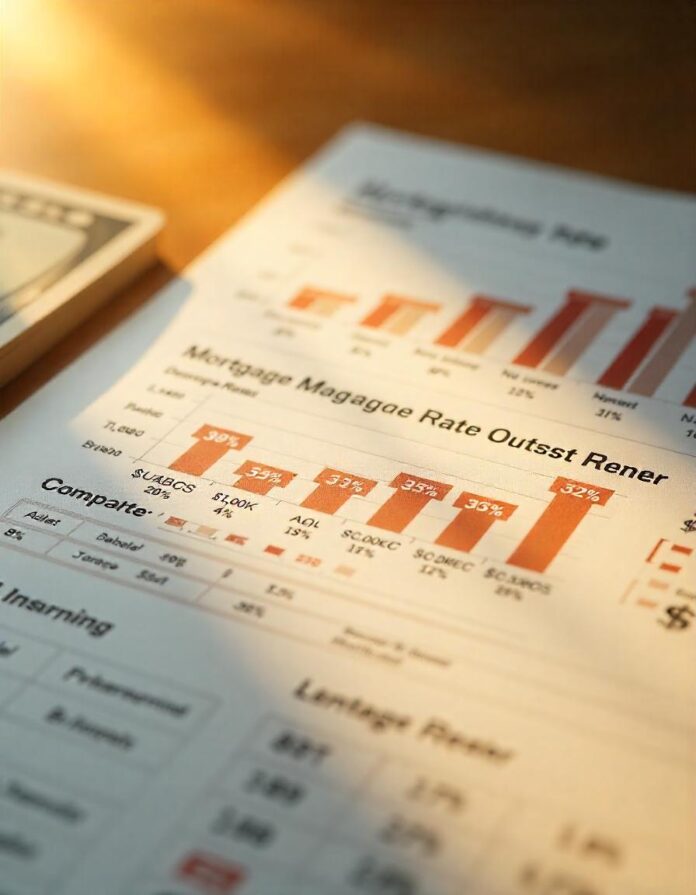Understanding mortgage interest rates today is vital for anyone considering buying a home, refinancing, or planning future financial steps. The current state of interest rates directly affects your borrowing costs, making it essential to stay informed about trends and factors that influence these rates. In this guide, we’ll explore the nuances of today’s mortgage interest rates, strategies to secure the best rates, and what you should know to make confident financial decisions.
Current Trends in Mortgage Interest Rates
As of today, mortgage interest rates remain a critical topic in the financial landscape. Key trends include:
- 30-Year Fixed Mortgages: Rates typically hover between 6.5% and 7%, depending on borrower qualifications and market conditions.
- 15-Year Fixed Mortgages: Lower rates compared to 30-year terms, often between 5.8% and 6.5%.
- Adjustable-Rate Mortgages (ARMs): Initial rates for ARMs, such as the 5/1 ARM, may start around 5.5% but can adjust annually after the fixed period ends.
Mortgage rates are influenced by broader economic indicators like inflation, employment data, and Federal Reserve policies. To monitor up-to-date rates, visit Bankrate or NerdWallet.
Factors Influencing Mortgage Interest Rates
1. Borrower’s Credit Profile
Your credit score is one of the most significant factors lenders consider. A score above 740 typically qualifies borrowers for the best rates, while scores below 620 may lead to higher rates or less favorable terms.
2. Loan Amount and Type
- Conforming Loans: Follow limits set by government agencies like Fannie Mae and Freddie Mac, offering competitive rates.
- Jumbo Loans: Higher loan amounts exceeding conforming limits often come with higher rates.
3. Down Payment Size
The larger your down payment, the lower your interest rate is likely to be. A 20% down payment often eliminates the need for private mortgage insurance (PMI), reducing overall costs.
4. Market and Economic Conditions
- Federal Reserve Policies: Decisions on federal funds rates indirectly influence mortgage rates.
- Inflation Trends: Rising inflation usually pushes rates higher, while lower inflation may stabilize or decrease rates.
5. Loan Term
Shorter loan terms, like 15 years, generally come with lower interest rates compared to 30-year loans. However, monthly payments are higher.
How to Secure the Best Mortgage Interest Rates Today
1. Improve Your Credit Score
Take proactive steps to enhance your credit score:
- Pay bills on time.
- Reduce credit card balances below 30% of your credit limit.
- Avoid opening new lines of credit before applying for a mortgage.
2. Compare Lenders
Don’t settle for the first offer. Use platforms like LendingTree to gather quotes from multiple lenders. Comparing offers can save thousands over the loan term.
3. Lock In Your Rate
Once you’ve identified a favorable rate, consider locking it in to avoid potential increases. Rate locks typically last between 30 to 60 days.
4. Opt for Discount Points
Paying for discount points upfront can lower your interest rate. One point equals 1% of the loan amount and can reduce your rate by about 0.25%.
5. Consider Timing
Certain times of the year may offer lower rates due to reduced demand, such as during the winter months.
Types of Mortgage Interest Rates
Fixed-Rate Mortgages
These loans feature an interest rate that remains constant for the entire term, offering predictability and stability.
Pros:
- Consistent payments.
- Ideal for long-term planning.
Cons:
- Typically higher initial rates than ARMs.
- Limited benefit if market rates drop.
Adjustable-Rate Mortgages (ARMs)
ARMs have an initial fixed period (e.g., 5 years) with lower rates, which adjust annually based on the market.
Pros:
- Lower initial rates.
- Potential savings if rates decrease.
Cons:
- Unpredictable future payments.
- Potential for rate hikes.
Why Today’s Mortgage Interest Rates Matter
Today’s mortgage rates impact:
- Affordability: Lower rates increase purchasing power, enabling you to buy a more expensive home.
- Monthly Payments: High rates translate into larger monthly obligations, potentially stretching budgets.
- Long-Term Costs: Even a small rate difference can save or cost tens of thousands of dollars over a loan’s life.
For instance, a $300,000 loan at 6.5% interest over 30 years results in monthly payments of $1,896, while the same loan at 5.5% reduces payments to $1,703.
The Role of Refinancing in Today’s Market
Refinancing can help homeowners take advantage of lower rates. Key benefits include:
- Reducing monthly payments.
- Shortening loan terms.
- Accessing equity through cash-out refinancing.
FAQs About Mortgage Interest Rates Today
1. What Is a Good Mortgage Interest Rate Today?
A “good” rate varies based on credit score, loan type, and market conditions. Generally, rates below 6% are considered favorable in the current market.
2. Can I Negotiate Mortgage Interest Rates?
Yes. Borrowers with strong credit and financial profiles can negotiate for better terms.
3. How Often Do Mortgage Rates Change?
Rates fluctuate daily based on economic data, lender policies, and market trends.
4. Should I Refinance If Rates Drop Slightly?
Refinancing makes sense if the savings outweigh closing costs. Analyze your break-even point before proceeding.
5. Are Online Lenders Reliable for Mortgages?
Many online lenders offer competitive rates and convenience. Always research reviews and compare offers before choosing.
Conclusion
Understanding mortgage interest rates today empowers you to make informed decisions, whether you’re purchasing a home or refinancing an existing loan. By improving your credit, comparing offers, and staying updated on market trends, you can secure a favorable rate that aligns with your financial goals


